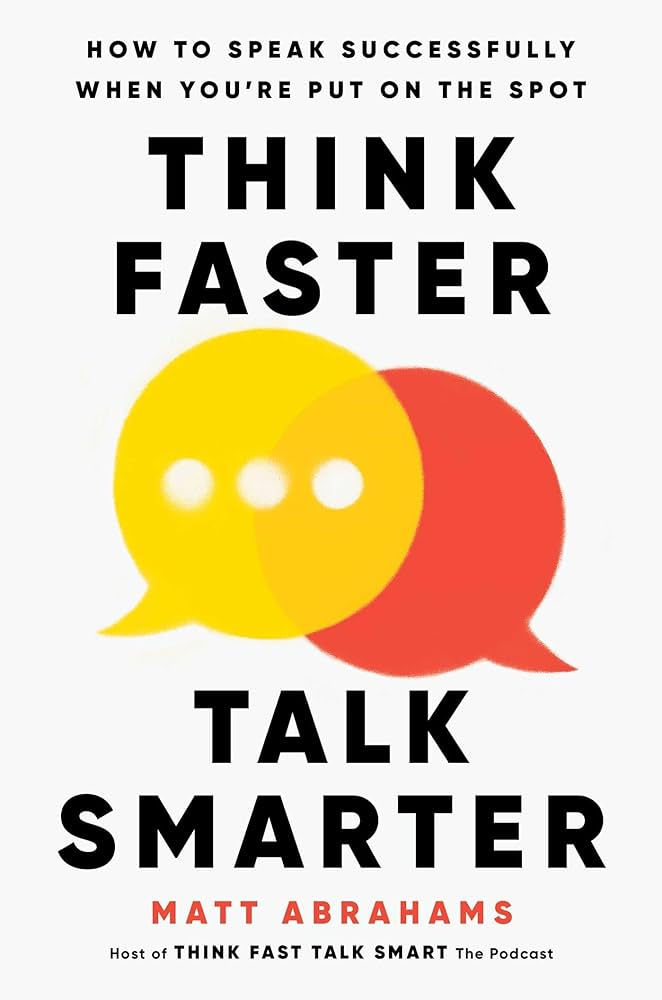Book Review - THINK FASTER, TALK SMARTER
- Lynda Wallace-Hulecki, Ed.D.
- Jan 15
- 4 min read

THINK FASTER, TALK SMARTER. How to Speak Successfully When You're Put on the Spot Hardcover. Matt Abrahams (2023, Kindle Edition)
Have you been haunted by occasions when you misspoke, fumbled an answer, or failed to impress in a spontaneous speaking situation? When put on the spot and asked to communicate, do you ever feel overwhelmed, confused or even threatened? The need to speak spontaneously crops up many times in everyday life. For many of us, the prospect of spontaneous communication is terrifying. According to the author of this book, Matt Abrahams, being adept at spontaneous communication isn’t something innate or deeply established in us, but rather how we approach this challenging task. Think Faster, Talk Smarter provides a concise, practical methodology for doing just that.
The book’s author, Matt Abrahams, is a lecturer in Organizational Behavior at Stanford University’s Graduate School of Business, and is also a coach and host of the popular Think Fast, Talk Smart The Podcast. In this book, Abrahams likens the mastering of spontaneous communication to the learning of a sport, whereby the first step is to absorb the foundational principles, then apply them in practice situations ⎯becoming more adept over time. Accordingly, he structures the book in two parts: Part 1 introduces the reader to fundamental strategies for transforming one’s communication abilities; and Part 2 provides specific techniques for navigating common communication challenges.
More specifically, in Part 1, Abrahams presents a six-part method for understanding the obstacles that so often interfere with impromptu speaking including strategies for managing anxieties (chapter 1: Calm), preventing perfectionism that often can hold people back (chapter 2: Unlock), and avoiding a closed or resistant mindset (chapter 3: Redefine). He also presents specific tools and tactics for use in excelling, including how to listen actively to the audience in order to understand what is really needed in the situation (chapter 4: Listen), how to structure content on the fly (chapter 5: Structure), and how to streamline ideas so they’re focused and compelling (chapter 6: Focus). A few highlights and takeaways from the 6 chapters that constitute Part 1 of the book follow.
In chapter 1 (Calm), Abrahams provides a useful chart that summarizes key strategies to tackle anxiety that can be used to develop a personalized Anxiety Management Plan. To illustrate, he emphasizes that speaking is all about breath and breath control. The faster you breathe, the faster you speak. Therefore, the technique of slowing your breathing can aid you in slowing your speech. Another useful strategy suggested for situations where you anticipate being called upon to speak spontaneously is to prepare one or more question(s) in advance to ask your audience if you become flustered.
In chapter 2 (Unlock), Abrahams asserts that embracing imperfect performance is the key to all successful spontaneous communication, and offers several strategies such as by reframing spontaneous interactions as “conversations” rather than “performances”, and by using more casual and informal language.
In chapter 3 (Redefine), Abrahams offers four shifts in mindset that include: reframing spontaneous communication as an opportunity rather than a threat; shifting one’s focus away from oneself and toward the audience; taking a positive posture to focus and build on points of agreement; and focusing on the next steps and recovery versus on dwelling on what went wrong.
In chapter 4 (Listen), Abrahams offers specific tools and tactics for becoming more attentive and listening better through the application of a 3-step framework.
In chapter 5 (Structure), Abrahams offers valuable tools and tactics for enabling spontaneity through the use of a structured approach to communication. To illustrate the value of a structured approach, Abrahams used a highly relatable example situation that many professionals, including this reviewer, have encountered… What to do if called upon to jump in unexpectedly and give a presentation for an absent colleague with only a few minutes’ notice. The application of the What–So What–Now What formula is a tool worthy of consideration!
Finally, in chapter 6 (Focus), Abrahams offers tools and tactics for delivering focused messages on an impromptu basis.
In Part II, Abrahams addresses some of the most common contexts in which people are called upon to express themselves in the moment, and offers specific techniques for navigating common communication challenges. Specifically, he delves into the following types of situations that are commonly encountered:
Networking and small-talk situations
Delivering toasts, tributes, and introductions
In making a persuasive and convincing pitch to wield influence in the moment
Handling impromptu Q&A sessions following a presentation, in meetings or an interview
In providing feedback that is constructive and can bolster relationships
In recovering from a situation in which you may have caused offense or behaved improperly
Similar to the approach Abrahams used in Part 1, he presents simple “recipes” for organizing what to say, as well as additional tips for effective communicating.
Throughout the book, Abrahams challenges conventional wisdom and provides counterintuitive techniques including specific tactics for the reader to try (labelled “Try It”), as well as exercises to practice key techniques in more depth (called “Drill It”). In addition, a QR code is provided in the second appendix that links to a Think Faster, Talk Smarter website for ongoing access to new materials and videos discussing and demonstrating concepts from the book as well as new emergent ones.
Overall, the book Think Faster, Talk Smarter , offers simple, actionable advice to help us think and speak more effectively in the moment. This book is an excellent reference and resource for leaders at all levels.





































Comments